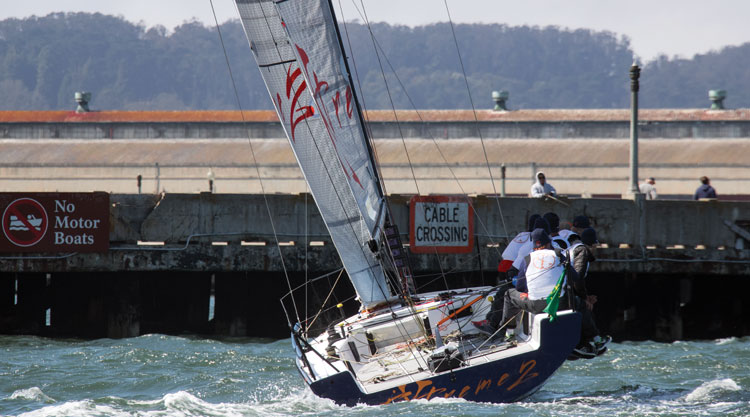Fall is finally here, and for those who aren’t lucky enough to live in places such as San Francisco, Newport, or Buzzards Bay, it’s time for the best breeze of the year. This may be a good time to brush up on heavy-air technique. Here are a few simple things to keep in mind when you are trying to go fast upwind in windy conditions.

Speed first
There is an age-old adage that defines making a boat go well upwind: speed first, and then work on pointing. This is always the case, but it is particularly important when the breeze is up. If you trim the way you do in medium conditions, the boat will just roll over and play dead. Compounding the problem are the waves which usually accompany big breeze. They take extra speed to get through.
So how do you go fast? Let’s start with the obvious: have your small headsail up and make sure both sails are as flat as you can make them (backstay, outhaul, and luff tension all on hard). The real key is to not trim as hard as you would in normal conditions. Start with the sails well eased so it is easy to get the boat going, and only gradually wind them in. When the boat gets hard to steer and keep moving, you’ve gone too far.
Balance the luff
Both sails need to be de-powered evenly. The most common mistake is to have the jib sheeted in hard and trying to do all the work with the mainsail. The headsail trimmer needs to consider how the jib is affecting the mainsail. If the mainsail is luffing completely in the puffs, to keep the boat on its feet you need to change the jib setup. Move the lead aft (or up and out if you have athwartship jib tracks) to flatten the foot and twist off the top of the sail. Don’t worry about the top of the sail luffing before the bottom. It should. If that doesn’t do it, ease the sheet an inch or two. You should be able to have the back half of the mainsail working (or at least the bottom battens) in the biggest puffs.
In the big blasts you will need to ease the jib as well as the mainsail. The trimmers should watch the heel and the telltales just as if they were driving. If the driver has to feather too much (come up and let the jib start to luff), then the sails need to be eased. Just a quick burp on the jib sheet will make a huge difference. It is ideal if you can trim the jib from the weather side.
Heel is all that matters
For the driver and trimmers a constant angle of heel is the goal. Don’t worry so much about the telltales. In the puffs the driver lets the boat come up instead of fighting the helm, and the trimmers ease as necessary. Too much heel and you will have too much weather helm. Too flat and you will not generate enough speed. Monohulls are very sensitive to small changes in heel angle. If you are looking for speed, bear off just a little bit to create a small amount of extra heel. Be patient. Don’t go too far chasing the speedo; speed will come. If it doesn’t, ease the sails.
Crush the waves
Classic teaching suggests that steering through waves should be a matter of coming up the front and then bearing off down the back side. In big ocean swells with lots of space between waves (or in really small boats) this works. However, for most of us, when we sail in waves, it is a short, steep chop with little spacing between waves relative to our boat’s length. Here again speed is your friend. Also, a little extra heel (just a tiny bit now, no rolling over!).
As a big set approaches, bear off slightly (easing sails as you do to keep heel under control) and hit them with pace. If you were averaging 6.3 knots you might want to be going 6.8. You also don’t want to hit a wave with the boat too flat. This will make it pound and slow down. This is the danger of trying to steer up the wave front. You are going to hit waves. There is usually little chance of steering completely around them. Hit them with extra speed and a touch of heel; then sheet back in and sail more upright in the flat spots.
by David Flynn
For more information visit quantumsails.com or contact David Flynn at [email protected]




